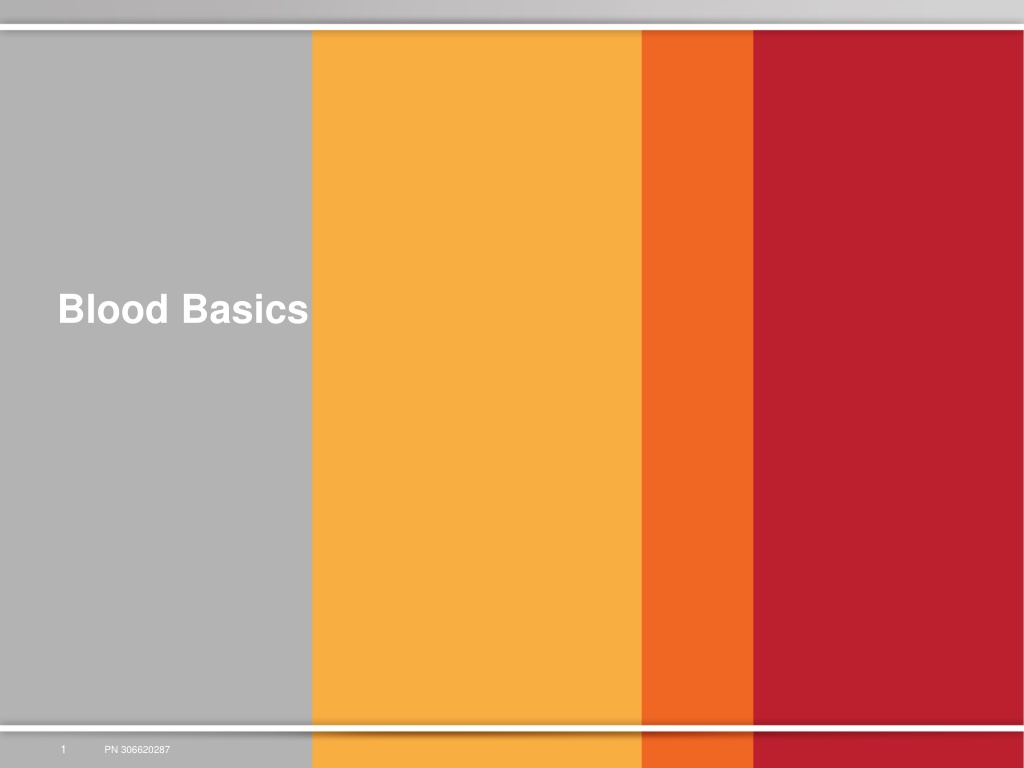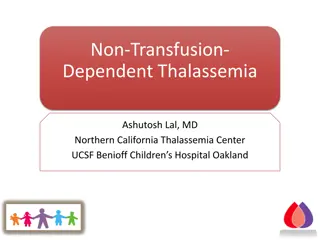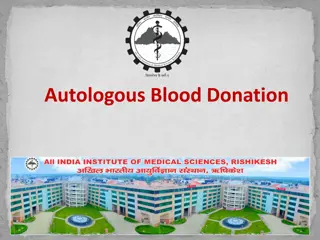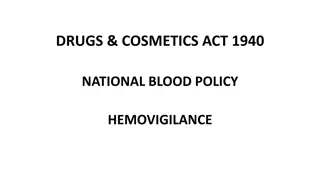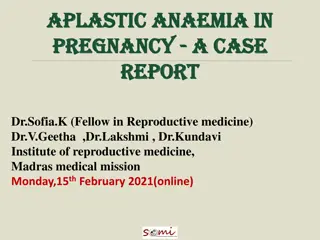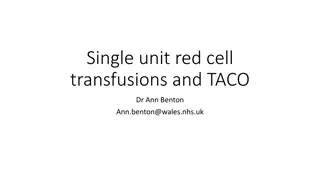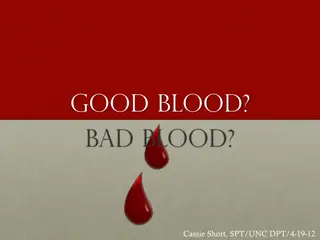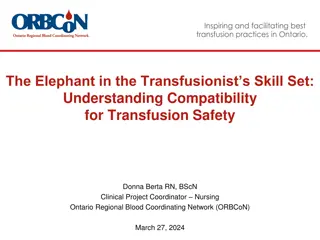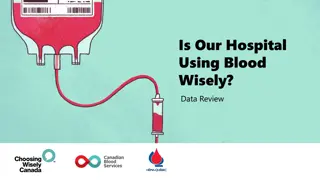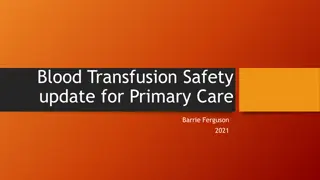Understanding the Basics of Blood and Transfusions
Blood is a vital tissue that performs essential functions like delivering oxygen and nutrients, maintaining immunity, and controlling body temperature. Blood transfusions save lives by treating accident victims, transplant recipients, cancer patients, and those with blood-related diseases. Components of blood include red blood cells, white blood cells, platelets, and plasma. Red blood cells carry oxygen throughout the body and have a shelf life of 35 to 42 days. Increasing blood donations can help address shortages and save lives.
Download Presentation

Please find below an Image/Link to download the presentation.
The content on the website is provided AS IS for your information and personal use only. It may not be sold, licensed, or shared on other websites without obtaining consent from the author. Download presentation by click this link. If you encounter any issues during the download, it is possible that the publisher has removed the file from their server.
E N D
Presentation Transcript
Blood Basics 1 PN 306620287
Learning Objectives To better understand the basics of blood To identify the components of blood To learn blood vocabulary To understand blood types 2
Basics of Blood Blood Factoids: In India someone will need a blood transfusion every two seconds One pint of blood can save up to three lives If only two more percent of all Indians would give blood, blood shortages would disappear for the foreseeable future1 Primary reasons people give for not donating blood:3 Afraid of needles Too busy No one ever asked me to donate There is no substitute for human blood4 1Delta Blood Bank, Blood Facts, www.deltabloodbank.org/donate/d/blood_facts.html, accessed on September 24, 2013. 2 Riley W, et al., The United States Potential Blood Donor Pool: Estimating the Prevalence of Donor-Exclusion Factors on the Pool of Potential Donors, Transfusion 2007; 47(7): 1180-1188. 3University of Maryland Medical Center, Reasons People Don t Give Blood, http://umm.edu/about/blood-drives/reasons-people-dont-give, accessed on August 1, 2013. 4 BloodBook, Blood Facts in General, www.bloodbook.com/facts.html, accessed on August 1, 2013. 3
Basics of Blood What is Blood? Blood is a tissue that provides four critical life-supporting functions: Delivers oxygen, hormones and nutrients to the body s cells Prevents blood loss by healing wounds Serves as the primary carrier for immunity Helps control body temperature 4
Blood Transfusions Blood transfusions are used to treat: Accident victims Organ and marrow transplant recipients Cancer and heart surgery patients People with blood-related diseases Sickle Cell Anemia Leukemia Hemophilia 5
Blood Components Whole Blood Composition Cellularcomponents: Red blood cells White blood cells Platelets Liquid component: Plasma 6
Blood Components Buffy Coat contains platelets and white blood cells 7
Components Red Blood Cells (RBCs) Purpose/facts: Contains a complex iron-containing protein called hemoglobin that gives blood its red color Carries oxygen to all parts of the body The body contains more RBCs than any other cell type Reasons for transfusion: Severe anemia Blood loss from injury Major surgery or disease Circulation life span about 120 days RBC unit shelf life 35 to 42 days 8
Blood Components White Blood Cells Purpose/facts: Key to the body s immune system Less than 1% of total blood volume; rarely collected for transfusions Only ordered when urgently needed The body's primary defense against infection Reasons for transfusions: Overwhelming infections In addition to/instead of bone marrow transplants Circulation life span few days to a few weeks White blood cell unit shelf life 4 to 6 hours 9
Blood Components Platelets Purpose/facts: Essential for blood clotting Forms platelet clot at an injury site Reasons for transfusions: Acute blood loss Reduced platelet production due to chemotherapy Improperly functioning platelets Open-heart surgery Organ transplants Circulation life span 7 to 10 days Platelet unit shelf life 5 to 7 days 10
Blood Components Transfusion Platelet Doses: These doses are on average and can vary for each patient. Trauma patients: 2 to 4 units in first 24 hours or until stabilized Organ transplant: Heart: 1 to 4 units Liver: 2 to 6 units Lung: 1 to 4 units Heart/Lung: 2 to 6 units Bone marrow: 2 to 4 units/day Premature baby (less than 30 weeks gestation): 1 unit/day Chemotherapy: 1 to 2 units/day Cardiac bypass: 1 to 2 units 11
Blood Components Plasma Purpose/facts: 90% water Carries blood cells, proteins, hormones and other substances Accounts for about 55% of total blood volume Fresh frozen plasma is used in transfusions Reasons for transfusions: Coagulation or bleeding disorders Acute blood loss Severe burns Plasma unit shelf life once frozen, can be stored for 1 to 7 years 12
Blood Vocabulary Antigen: Substance, usually a protein, that stimulates production of an antibody and is found on red blood cells, white blood cells and platelets Antibody: Protein that is found in plasma is produced in response to a foreign substance such as transfused cells or invading organisms Hemoglobin: Oxygen-carrying pigment of red blood cells that gives them their red color and serves to carry oxygen to the tissues Hematocrit: Blood test that measures the percentage of whole blood volume that is made up of red blood cells 13
Blood Types What makes blood a certain type: There are 30 major blood group systems (including the ABO and Rh systems) Each is genetically inherited and expresses antigens on red blood cells that are unique There are more than 400 blood group antigens Your blood type is determined by your parents Mother is A and father is B = child will be AB Mother is B and father is O = child possible B or O Mother is O and father is O = child possible O 14
Blood Types The ABO blood group: The most important blood group system in blood banking ABO antibodies are found in the plasma Antibodies to the ABO antigens appear naturally in the plasma after birth ABO incompatibility between recipient and donor is a serious complication 15
ABO Type Type A: Inherit an A antigen on their RBCs Type B: Inherit a B antigen on their RBCs Type AB:Inherit both an A and a B antigen *The universal RBC recipient Type O: Does not display any ABO antigens *The universal RBC donor 16
Blood Types The Rh system: Clinically, the most important blood group system after ABO Also inherited from our parents, but inherited independently of the ABO blood type alleles The presence or absence of the Rh ( D ) antigen on a red blood cell determines whether a person is Rh+ or Rh- The Rh antibody does not naturally occur and only develops after exposure to RBCs that contain the D antigen 17
Donors and Recipients by Blood Type Donor Type O- O+ B- B+ A- A+ AB- AB+ AB+ AB- Donor A+ Recipient Type O- O+ B- B+ A- A+ AB- AB+ A- AB+ B+ AB- B- Recipient A+ O+ A- O- B+ B- O+ O- 18
Learning Objectives To better understand the basics of blood To identify the components of blood To learn blood vocabulary To understand blood types 19
References AABB, Donor Services Training: Everything you Need to Know to Process Donors, 2010, AABB, Bethesda, Maryland. AABB, Technical Manual, 2011, 17th edition, AABB, Bethesda, Maryland. Dailey JF, Dailey s Notes on Blood, 2002, fourth edition, Medical Consulting Group, Arlington, Massachusetts. McLeod BC, et al. (eds.), Apheresis Principles and Practice, third edition, AABB Press, Bethesda, Maryland. 20
